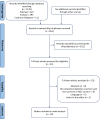Extravascular lung water levels are associated with mortality: a systematic review and meta-analysis
- PMID: 35794612
- PMCID: PMC9258010
- DOI: 10.1186/s13054-022-04061-6
Extravascular lung water levels are associated with mortality: a systematic review and meta-analysis
Abstract
Background: The prognostic value of extravascular lung water (EVLW) measured by transpulmonary thermodilution (TPTD) in critically ill patients is debated. We performed a systematic review and meta-analysis of studies assessing the effects of TPTD-estimated EVLW on mortality in critically ill patients.
Methods: Cohort studies published in English from Embase, MEDLINE, and the Cochrane Database of Systematic Reviews from 1960 to 1 June 2021 were systematically searched. From eligible studies, the values of the odds ratio (OR) of EVLW as a risk factor for mortality, and the value of EVLW in survivors and non-survivors were extracted. Pooled OR were calculated from available studies. Mean differences and standard deviation of the EVLW between survivors and non-survivors were calculated. A random effects model was computed on the weighted mean differences across the two groups to estimate the pooled size effect. Subgroup analyses were performed to explore the possible sources of heterogeneity.
Results: Of the 18 studies included (1296 patients), OR could be extracted from 11 studies including 905 patients (464 survivors vs. 441 non-survivors), and 17 studies reported EVLW values of survivors and non-survivors, including 1246 patients (680 survivors vs. 566 non-survivors). The pooled OR of EVLW for mortality from eleven studies was 1.69 (95% confidence interval (CI) [1.22; 2.34], p < 0.0015). EVLW was significantly lower in survivors than non-survivors, with a mean difference of -4.97 mL/kg (95% CI [-6.54; -3.41], p < 0.001). The results regarding OR and mean differences were consistent in subgroup analyses.
Conclusions: The value of EVLW measured by TPTD is associated with mortality in critically ill patients and is significantly higher in non-survivors than in survivors. This finding may also be interpreted as an indirect confirmation of the reliability of TPTD for estimating EVLW at the bedside. Nevertheless, our results should be considered cautiously due to the high risk of bias of many studies included in the meta-analysis and the low rating of certainty of evidence. Trial registration the study protocol was prospectively registered on PROSPERO: CRD42019126985.
Keywords: Critically ill patients; Hemodynamic monitoring; Lung edema; Transpulmonary thermodilution.
© 2022. The Author(s).
Conflict of interest statement
Dr. Monnet is member of the Medical Advisory Board of Pulsion Medical Systems, Getinge. He received fees for scientific lectures from Baxter and Philips, and restricted research grants from Baxter. Dr. Teboul is member of the Medical Advisory Board of Pulsion Medical Systems, Getinge. Dr. Chew has received travel reimbursements and honoraria from Pulsion Medical Systems and Edwards Lifesciences. Dr. Huber was member of the Medical Advisory Board of Pulsion Medical Systems. Dr. Kirov is member of the Medical Advisory Boards of Pulsion Medical Systems and Philips. Dr. Lahmer received travel grants from Gilead, Pfizer and MSD. Dr. Malbrain is founding President of WSACS (The Abdominal Compartment Society,
Figures
Similar articles
-
[Extended hemodynamic monitoring using transpulmonary thermodilution Influence of various factors on the accuracy of the estimation of intrathoracic blood volume and extravascular lung water in critically ill patients].Anaesthesist. 2005 Apr;54(4):319-26. doi: 10.1007/s00101-005-0809-2. Anaesthesist. 2005. PMID: 15726244 German.
-
Assessment of cardiac preload and extravascular lung water by single transpulmonary thermodilution.Intensive Care Med. 2000 Feb;26(2):180-7. doi: 10.1007/s001340050043. Intensive Care Med. 2000. PMID: 10784306
-
Quantitative computed tomography in comparison with transpulmonary thermodilution for the estimation of pulmonary fluid status: a clinical study in critically ill patients.J Clin Monit Comput. 2019 Feb;33(1):5-12. doi: 10.1007/s10877-018-0144-1. Epub 2018 Apr 21. J Clin Monit Comput. 2019. PMID: 29680878
-
Transpulmonary thermodilution.Curr Opin Crit Care. 2023 Jun 1;29(3):223-230. doi: 10.1097/MCC.0000000000001047. Epub 2023 Apr 10. Curr Opin Crit Care. 2023. PMID: 37083621 Review.
-
Extravascular lung water measurements in acute respiratory distress syndrome: why, how, and when?Curr Opin Crit Care. 2018 Jun;24(3):209-215. doi: 10.1097/MCC.0000000000000503. Curr Opin Crit Care. 2018. PMID: 29608455 Free PMC article. Review.
Cited by
-
Capillary leak and endothelial permeability in critically ill patients: a current overview.Intensive Care Med Exp. 2023 Dec 20;11(1):96. doi: 10.1186/s40635-023-00582-8. Intensive Care Med Exp. 2023. PMID: 38117435 Free PMC article. Review.
-
The influence of sex, age, and body height on the pulmonary vascular permeability index - a prospective observational study.Sci Rep. 2024 Sep 23;14(1):22001. doi: 10.1038/s41598-024-72967-y. Sci Rep. 2024. PMID: 39322748 Free PMC article.
-
A multicentre, randomised controlled clinical trial evaluating the effect of the adsorptive filter oXiris on haemodynamics in abdominal septic shock patients requiring continuous renal replacement therapy (Oxiris for Abdominal SEptic Shock study).BMJ Open. 2025 Jul 8;15(7):e094792. doi: 10.1136/bmjopen-2024-094792. BMJ Open. 2025. PMID: 40633959 Free PMC article.
-
Fluid management in septic patients with pulmonary hypertension, review of the literature.Front Cardiovasc Med. 2023 Mar 2;10:1096871. doi: 10.3389/fcvm.2023.1096871. eCollection 2023. Front Cardiovasc Med. 2023. PMID: 36937900 Free PMC article. Review.
-
Relationship of Extravascular Lung Water and Pulmonary Vascular Permeability to Respiratory Mechanics in Patients with COVID-19-Induced ARDS.J Clin Med. 2023 Mar 3;12(5):2028. doi: 10.3390/jcm12052028. J Clin Med. 2023. PMID: 36902815 Free PMC article.




